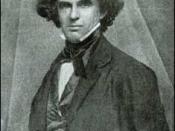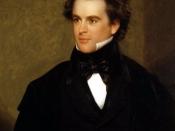The Minister?s Black Veil-Character I chose to write on Hawthorne?s, The Minister?s Black Veil. I considered the character?s in the story intriguing, from the mystery they portrayed. The characters in this story, and any story, consist of a protagonist and an antagonist. Some label the protagonist as the good guy, or ?white hat,? and the antagonist the bad guy, or ?black hat.? The protagonist in this story was Mr. Hooper. He was the town reverend, and everyone listened to his word on every Sabbath day. The people of the town were frightened and astonished by the black veil he wore, but he was still the same person underneath the veil. He was not intending to harm anyone. So, I felt I could label him the protagonist of the story. I also believed that veil itself was a form of a protagonist. The veil was placed there, not to scare the people, but to block the evil in the world that Mr.
Hooper was infected with, or hiding from. The town?s people considered the veil evil instantly. They did not even attempt to ask the reverend why he wore the veil, so they were never informed on the true meaning. Instead of asking why he wore it, they wondered and made assumptions.
There was no single antagonist in this story. The whole community, from his fiancee, Elizibeth, to the sexton, down to Reverend Mr. Clark, who wished Mr. Hooper his final blessings before his passing. The whole town deemed Mr. Hooper as this man of evil and dark mystery. They turned Mr. Hooper away, and looked at him as a freak show, not as the melancholy Reverend he once was. The way Hooper was shut out from his community was part of the demise of the Reverend. When he walked out of his church, he saw children playing, and like always he gave kind notice to the children. Instead of acknowledging the Reverend, the children ran in fear. That tore at Mr. Hooper. He was also hurt by the leaving of his love, Elizabeth, who wouldn?t stay with him through such desperate times. If the community had tried to understand why the man decided to wear a piece of crape over his face, instead of tearing him apart, his life would have been worth going on. Before the town showed fear of the veil, he was comfortable with the veil, and I believe his life could have gone on to the fullest.
This short story has come to the attention of readers, and some have written critical summaries, or essays, about The Minister?s Black Veil. One of these critiques is by a man named, William Freedman. Freedman wrote, The Artist?s Symbol and Hawthorne?s Veil: ?The Minister?s Black Veil? Resartus. The author touched on the meaning of the veil, from an artistic and symbolic view. He believes that, the significance of the veil, was the symbolization of the hiding of Hawthorne?s own personal demons. He believed this was Hawthorne?s way to release some of his pain from the sin he held. He also agrees with my statements earlier, that the veil is merely a piece of crape, and the congregation is the cause of the fall of the reverend. All through Freedman?s essay, he commented on the similarities between Reverend Hooper and Nathaniel Hawthorne. Freedman also made the veil out to be a moral message. When Mr. Hooper was breathing his last breath, he saw everyone around him with a black veil. The moral message, is in life everyone wears a black veil to hide their sins and vices form the outside world. Everybody?s appearance on the outside is hiding what they are really feeling inside.
Another critical essay, was written by Ronald E. McFarland. Community and interpretive communities in stories by Hawthorne, Kafka, and Garcia Marquez talks about the community in The Minister?s Black Veil. He touches on the towns reaction to the dawning of the veil, and how the people of the town instantly shut out Mr. Hooper without even knowing the purpose behind the veil. McFarland is saying the reverend is so hurt by everyone turning their backs to him, that lead to his death. He proves his point by adding to his essay, ?It is the failure of ?the friend? to show ?his inmost heart to his friend; the lover of his best beloved.? The tragedy of the story is not so much the failure of Elizabeth?s love or even the Reverend Mr. Hooper?s isolation from the human community, but the ?mutual affright? with which the ?auditors shrank from one another,? failing each other even after his horrid revelation.
It is clear to me, that there are more important characters in this story, than just Mr. Hooper. The veil had an impact on the congregation, so great, it became its own character. The town itself was a main character, which gave boundaries to Mr. Hooper?s life. After reading the two critical essays, I also learned some things that never crossed my mind while reading, The Minister?s Black Veil. I never thought of Nathaniel Hawthorne using the story to express his own life, and his own demons. I saw that after reading these essays. The combination of characters shaped the story well, and gives the reader a sense of detailed description throughout the story.


